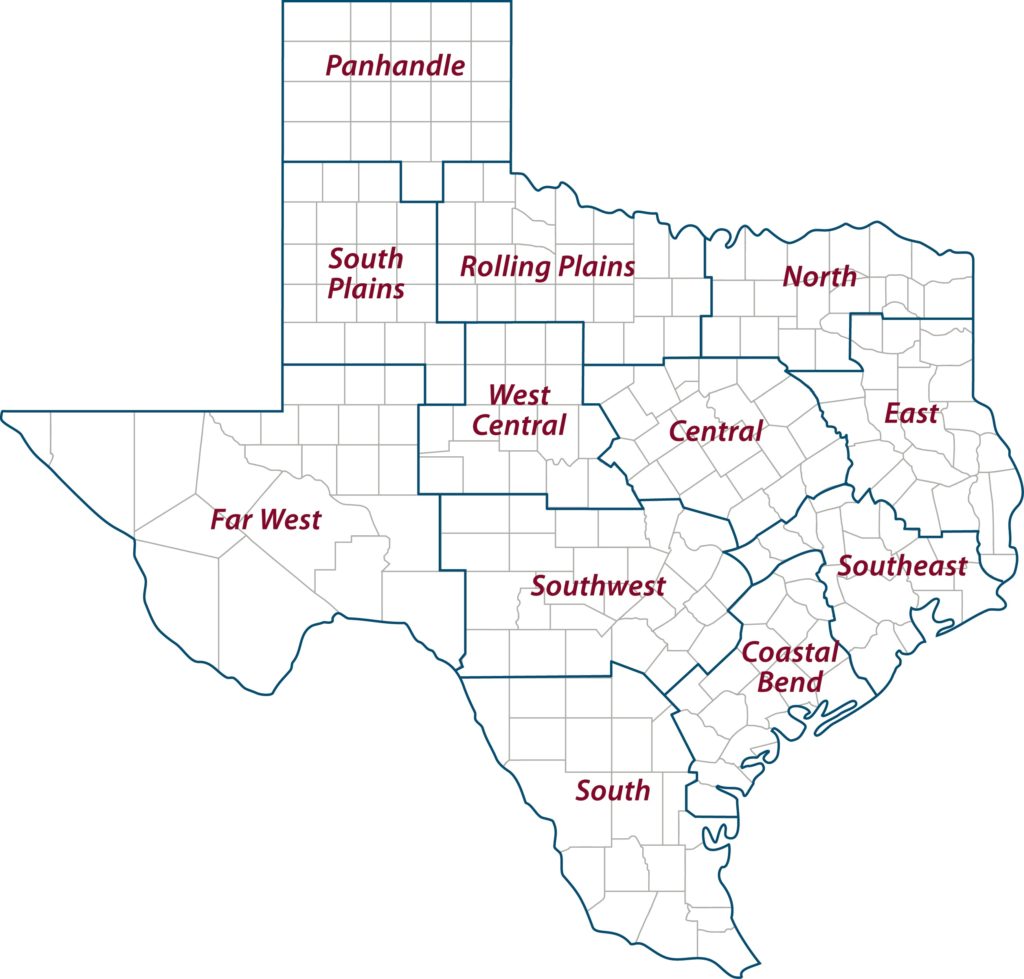Egg prices climbing as Easter approaches
Texas Crop and Weather Report – March 29, 2022
Egg prices continue their seasonal upward trend heading into Easter, but a looming threat of avian influenza could exacerbate long-term costs at grocery stores, according to Texas A&M AgriLife Extension Service experts.

The latest U.S. Department of Agriculture retail egg price report showed a dozen large Grade A eggs reached $2.01 a dozen compared to $1.60 per dozen last year, a 25.5% increase. Egg prices typically trend higher and peak around the Easter holiday.
David Anderson, Ph.D., AgriLife Extension economist, Bryan-College Station, said higher production costs, especially feed, and lower production volumes are likely triggering rising prices. Retail egg prices were the highest per dozen for this time of year since 2016.
Higher seasonal demand for eggs is driven by traditional Easter activities, including dying eggs and baking, Anderson said.
“It’s worth mentioning that we’ve had higher prices than this in the past, but it is clear that feed costs are higher,” Anderson said. “Then it is a matter of those higher production costs being passed on to consumers.”
Egg prices and beyond
Beyond the typical holiday demand and price spike, Greg Archer, Ph.D., AgriLife Extension poultry specialist, Bryan-College Station, said higher prices for feed components like soybeans and corn could keep prices higher.
Another threat to long-term egg prices could be the ongoing spread of a highly pathogenic avian flu that has been found in more than a dozen states from Maryland to South Dakota.
Outbreak reports have mostly occurred in backyard flocks, according to the USDA, but almost 12 million commercial chickens and turkeys, including more than 1 million laying hens, have been destroyed to control the spread. Outbreaks have been reported in two major egg-producing states – Iowa and Minnesota. There are more than 300 million egg-producing hens in the U.S. poultry flock.
In 2015, egg-laying operations were devastated by major outbreaks of avian influenza. Around 50 million chickens and turkeys were culled from the nation’s flocks as a preventive measure to halt the disease’s spread. The outbreak impacted more than 10% of the nation’s egg production capacity and caused egg prices to double.
“There is concern among Texas producers, but hopefully, we can avoid major outbreaks here,” he said.
Anderson said higher production costs and subsequent higher retail prices for consumers would only be exacerbated by major outbreaks in egg-production operations. The highly pathogenic avian influenza outbreaks have implications for all forms of poultry production, including broiler chickens that provide meat and turkeys.
“In the short term, the trend is upward, and the price of production is higher, so we can expect higher prices. But if the outbreaks become a major problem, we could see prices really climb,” he said. “The last time this happened, it did worsen through the spring before it got better, so this could impact us beyond eggs and cause issues with turkeys this coming fall.”
AgriLife Extension district reporters compiled the following summaries:

CENTRAL
Some severe weather was reported. Very little rain was reported, but straight-line winds damaged barns and grain bins. Soil moisture was very short in nearly all counties. Crop, rangeland and pasture conditions were poor in nearly all counties. Crops were in poor condition due to drought. Dryland wheat and oats were not doing well and may fail. Livestock were in fair condition and being supplemented with feed and hay. Fires were being reported daily.
ROLLING PLAINS
Parts of the district received up to 1 inch of rain, and several areas reported trace amounts of rainfall up to half an inch. Rain should help rangeland and wheat conditions. Most wheat under irrigation looked good. No cotton was planted yet, but some fieldwork was being done. A few corn and sorghum fields were planted. Pastures remained in poor condition. Cattle were provided supplemental feed, and few native grasses were available for grazing. Calving was underway, and cows were in fair to good condition. Ponds were drying up. Several wildfires were reported.
COASTAL BEND
Central and northern parts of the district received some rain. High winds coupled with low humidity continued to create a fire threat. Corn and most grain sorghum emerged but needed rain. Cotton planting was underway, but most cotton planting should start when soils warm up and wet areas dry enough for producers to get equipment into fields. Rice producers were planting. Pastures were starting to green up in areas that received rain, but there was still not much growth. Spring calving was underway. Livestock body conditions were declining, especially for cows with calves. Producers continued to supplement herds with protein and hay. Hay inventory levels were still adequate, and market prices remained very high.
EAST
A few counties were impacted by the recent tornadoes. Houston County reported major losses of barns, fences, working pens and some livestock. Pasture and rangeland conditions were fair. Subsoil and topsoil conditions were adequate. Recent rainfall relieved drought conditions a little, but warmer temperatures and heavy winds were drying soils. Supplemental feeding decreased as cool-season forages increased productivity following recent rains. Livestock were in fair to good condition with some diet supplementation taking place. Wild pig activity continued.
SOUTH PLAINS
Dry conditions continued across the district. Green chop triticale was rapidly maturing under pivot irrigation. Fieldwork, including cleaning fields and preparing beds for planting, continued. Producers were continuing to pre-water fields. Winter wheat needed moisture. Cattle were on supplemental feed. A grassfire was reported. Farmers were busy getting fields ready for spring planting.
PANHANDLE
Soil moisture levels were very short to short. Some general rainfall and snow provided some moisture, but much more was needed to restore soil moisture and crop conditions to normal. Producers with irrigation were watering wheat to get some growth for stocker cattle. Rangeland and pasture conditions were very poor to poor. Cattle diets were being supplemented on rangeland.
NORTH
Soil moisture was mostly adequate. Decent rains amounted to between 0.5-1 inch of rainfall. Winter wheat and oats were in fair to good condition. Corn was being planted. Pasture and rangeland were mostly in poor to fair condition.
FAR WEST
Conditions were windy with no precipitation. Temperature highs were in the low- to middle-70s, with lows in the high 30s to low 40s. Rangeland conditions were extremely dry. Only irrigated wheat fields remained. Pre-irrigation for cotton continued, and some pecan orchards and alfalfa fields were receiving water as well. There were reports of hickory shuckworms in pecan trees. The Lower Valley was being irrigated with effluent from the City of El Paso, some private wells, and some El Paso County Water Improvement District No. 1 wells. Water quality issues were a problem during this critical time. The Upper Valley was irrigating crops with private wells, but the water quality was very good. Some fires reached West Texas, and due to the high winds, ranchers were forced to move the cattle to different sections of their ranches. Forage producers were unable to spray fields with pesticides due to high winds. Producers continued to feed wildlife and livestock.
WEST CENTRAL
Conditions were dry and windy. The forecasted rain did not deliver, and high winds worsened conditions. Wheat remained in very poor condition. Some producers started to turn on irrigation to build some soil moisture for corn acres. Producers reduced livestock inventory as feeding costs were higher than potential price gains.
SOUTHEAST
Temperatures were up and down with cold fronts and a high of 87 degrees. Pasture and rangelands were in very poor to good condition, but a burn ban was in effect. Some areas reported decent rainfall, and more rain was in the forecast. Subsoil moisture was very short to adequate as corn planting wrapped up, and cotton planting started. Some wind damages were reported from recent storm systems. Rice planting was progressing. Warm-season grasses were showing signs of growth.
SOUTHWEST
No measurable rainfall was reported. Risk of fires increased as low moisture and windy conditions continued. Rangeland and pasture conditions were in short supply of adequate forage. Wheat looked good under irrigation. Hay producers began irrigating. Planting of corn, cotton and sorghum continued. Producers provided heavy supplemental feed rations and culled livestock inventories, but markets were steady. Livestock looked fair to good overall.
SOUTH
Most areas reported short soil moisture levels, but some parts of the district reported very short or adequate soil moisture conditions. Some counties reported brief thunderstorms and trace amounts of rainfall. Most farmers continued to wait for significant rainfall before planting, but some had already planted corn and sorghum and were preparing to plant cotton. Some planted sorghum acres failed to create stands. Sunflowers, corn and grain sorghum looked good in some areas but will need rainfall soon. Some corn was under irrigation. Onions, vegetables, sugarcane and citrus were being harvested. Rangeland and pasture conditions were poor. Ranchers continued to provide heavy rations of supplemental feed to livestock. More producers were looking for hay as supplies continued to dwindle. Feed and hay prices continued to rise. Stock tanks were low, and some producers were hauling water. Some producers will be forced to cull deeper if drought conditions persist. Cattle prices were steady for all classes, and sale volumes were normal. Some hay fields were being irrigated. Fire activity was rising across the district, with more than 4,000 acres reported burned in two counties. Fires have caused widespread damage to ranching operations. Wildlife were browsing along roadsides.


